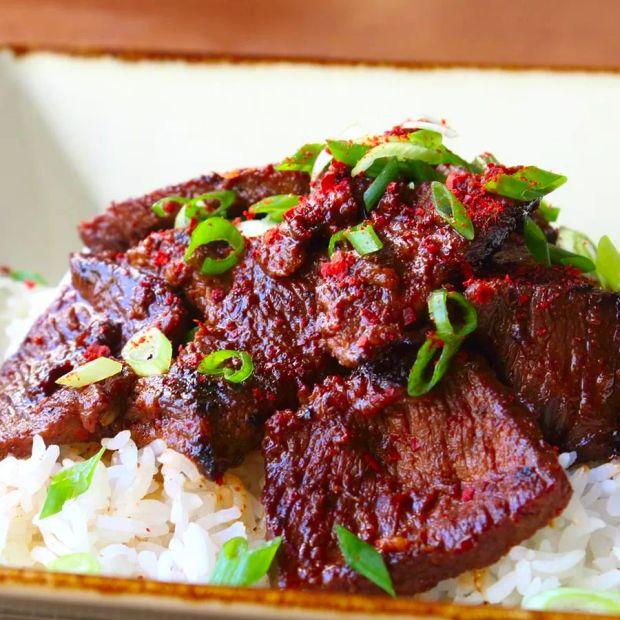What is Bulgogi? A beloved Korean dish that features thinly sliced beef, grilled to perfection with a sweet and savory glaze.

What is Bulgogi?
Bulgogi, a staple of Korean cuisine, is made from thin slices of ribeye, tenderloin, or sirloin beef marinated in a sweet-savory sauce, then grilled over an open flame. The name 'Bulgogi' comes from 'bul', meaning fire, and 'gogi', meaning meat. This dish dates back to Korea’s ancient Goguryeo kingdom, where it was enjoyed as a communal meal. When you try these perfectly caramelized, melt-in-your-mouth pieces of meat, you'll understand why Bulgogi remains a time-honored favorite. It's often served with rice, lettuce leaves, and an array of side dishes, allowing for a truly personalized and delightful dining experience.

The Heart of the Dish
While Korean barbecue can be made with a variety of meats like pork belly, chicken, or even beef tongue, the true classic is beef bulgogi. Ribeye, sirloin, or tenderloin are the prime cuts to use, but for a more affordable option, flank or skirt steak will work—just be sure to marinate it longer. Look for cuts with beautiful marbling, as this is key to achieving that melt-in-your-mouth tenderness when combined with the marinade.
To prepare the beef, slice it thinly against the grain, ensuring each piece is paper-thin. Some people recommend slicing the beef while it's partially frozen for perfectly uniform slices, or you can have your butcher do it for you.
The authentic bulgogi marinade blends soy sauce, sugar (white or brown), sesame oil, minced garlic, onion, and Asian pear, which gives the sauce a delicate sweetness. Be sure to use a true Asian pear—more apple-like than a regular pear—for the best results. Some variations include sweet rice wine, apple juice, or even soda like Coca-Cola for extra sweetness. For a deeper flavor, try adding gochujang, a fermented red chili paste with a complex mix of sweet, savory, spicy, and smoky notes. Let the beef marinate for at least 2 hours, or overnight for more flavor.
When you're ready to cook, take the marinated beef out and let it come to room temperature for about 30 minutes. The cooking itself is quick—just get your grill, skillet, or wok very hot before placing the meat on. The goal is for the beef to sizzle, caramelizing around the edges while keeping the center tender. Flip the beef when you see moisture form on the top side, and cook for just a few minutes. Overcooking will result in dry, tough meat. For a saucier result, you can cook the beef with its marinade in a skillet, letting the savory-sweet sauce soak into the rice. Garnish with chopped scallions and toasted sesame seeds.
The Art of Enjoying Bulgogi
Bulgogi isn't just about its rich flavors; it’s also about the interactive, communal experience where each bite is personalized to suit every diner’s tastes.
Imagine this: an authentic Korean meal begins with a spread of small side dishes, or banchan, designed to complement the barbecue throughout the meal. There are countless varieties of banchan—from spicy cucumber salad and seasoned soy eggs to stir-fried fish cakes and dried seaweed. Other options might include pickled radishes, sweet potatoes, enoki mushrooms, stir-fried zucchini, steamed eggplant, or seasoned greens like spinach, cabbage, and watercress.

Thinly sliced marinated beef is cooked right in front of you on a sizzling grill placed at the center of the table. To recreate this authentic Korean dining experience at home, invest in a portable Korean BBQ grill and cook the beef for everyone to enjoy as it sizzles and fills the air with mouthwatering aromas. Alternatively, you can serve the beef on a sizzling fajita platter, available at most Korean markets. The perfectly seared beef is typically paired with steamed white rice, fresh lettuce, and kimchi.
Ssam, which means 'wrapped,' is a beloved Korean tradition where rice, meat, and other fillings are wrapped in leafy greens. You can use any variety of lettuce that suits your taste, with popular choices including Korean perilla leaves, red-leaf lettuce, Boston lettuce, and even steamed or parboiled cabbage. The idea is to make bite-sized wraps, and everyone has their own style. Some prefer to use multiple leaves, adding a little rice along with the meat, then topping it off with kimchi and any desired spicy sauces or banchan. A dollop of ssamjang, a tangy and fermented Korean barbecue sauce, completes the perfect bite with the sweet-savory beef bulgogi.

While many enjoy bulgogi by wrapping it in lettuce, others prefer it served directly on or mixed into their rice, with added banchan and sauces. For the perfect pairing, try Korea's national drink: soju, a clear rice wine similar to Japan's sake. Geonbae! (That’s 'Cheers!' in Korean!)
Gather your closest friends and family to create a memorable bulgogi feast that will leave everyone impressed.
Check out these top-rated bulgogi recipes to kickstart your culinary adventure:
- Beef Bulgogi
- Korean Spicy Marinated Pork (Dae Ji Bool Gogi)
- Dak Bulgogi (Korean Barbeque Chicken)
Evaluation :
5/5



